This Easy Homemade Bug Spray is Affordable, Refreshing on Skin, & It Actually Works!
Stay bite-free this summer with my homemade bug spray recipe!

Buh-bye, bugs and chemicals! 👋🏼
Ditch the chemicals and bugs! My homemade bug spray using essential oils is easy, moisturizing, safe for the family, and most importantly…it really works!
If you’re not buying a bug repellent so good you could eat it, then consider making my affordable and easy homemade bug spray!
But first, what’s wrong with commercial bug sprays? 🤔

DEET is my #1 concern when it comes to any bug repellant. About one-third of the US population uses DEET every year! 😱
While the topic of DEET remains controversial, the EPA (Environmental Protection Agency) last stated in 2014 that they still stand by there not being any health concerns with using DEET. However, it’s hard not to remain skeptical with the lengthy list of warnings they put on each label containing DEET. 😒
That’s not to mention the other harmful chemicals that accompany it. Plus, they all typically smell awful, feel greasy, and probably aren’t suitable for sensitive skin.
And don’t get me started on all the toxic chemicals flying under the radar in many store-bought bug sprays, cosmetics, lotions, etc. 😳
Here are just some of the EPA-listed warnings for DEET I find really concerning:
- Use just enough repellent to cover exposed skin and/or clothing.
- Do not use under clothing.
- Avoid over-application of this product.
- After returning indoors, wash treated skin with soap and water.
- Wash treated clothing before wearing it again.
- The use of this product may cause skin reactions in rare cases.
Safe? Nah…this is one time in my life where moderation isn’t key and I’ll stick to my much more natural approach. 🙌
Let’s find out what bugs hate so we can make the perfect homemade bug spray that WORKS:
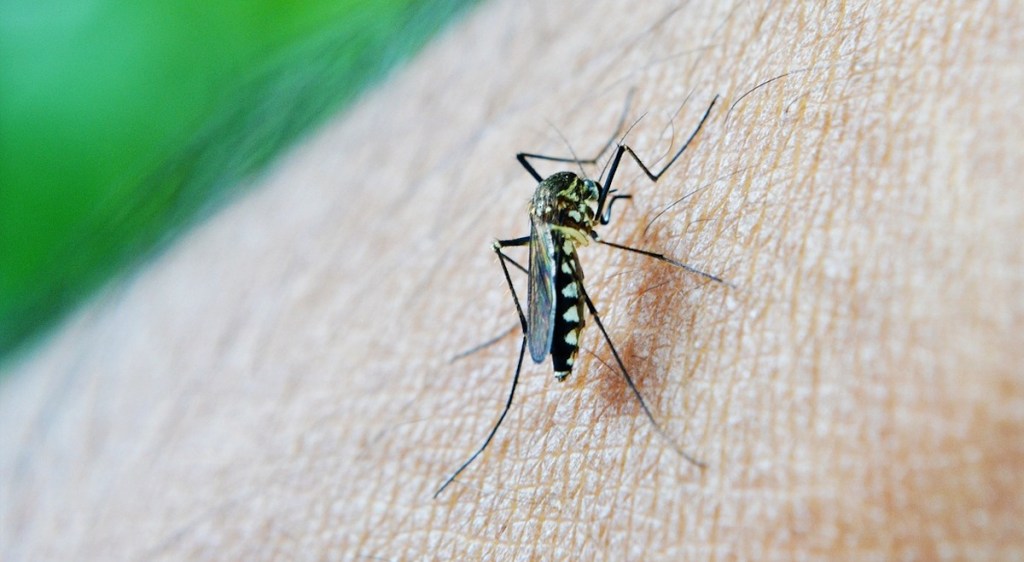
Mosquitos hate: Citronella, Lavender, Peppermint, Clove, Cedarwood, Eucalyptus, Rosemary, Lemongrass, Basil, Catnip
Black flies hate: Mint (specifically Peppermint), Basil
Ticks hate: Lemon, Orange, Citrus, Cinnamon, Lavender, Peppermint, Rose Geranium
I’ve developed a homemade bug spray recipe just for you that will get rid of pesky bugs and moisturize your skin without being greasy. Even better, it smells good too! 😍
No one wants a difficult recipe, so I’ve also made this homemade bug spray incredibly easy to whip up, take with you on the go, and spray on quickly before heading out the door. 🙌
Before we get started, there are some important factors to keep in mind when making the best Homemade Bug Spray:
You need the right essential oils.
I bought Theraputic Grade Essential Oils on Amazon! Each one is completely safe for your skin since they’re 100% pure and therapeutic grade. The kit I found has everything I needed to whip up this bug spray recipe and then some since it includes tons of different scents.
The kit is perfect for anyone who plans to make my homemade bug spray and plans to diffuse essential oils or make their own cleaning products at home to get the most bang for their buck! Even better, they recently started offering a 6-piece kit that’s even cheaper and still has all of the essential oils you’ll need for this recipe.
Did I mention it’s also super affordable?

URPOWER Essential Oils Kit – 6 pack – $8.99 (regularly $14.99)
That’s just $1.49 per bottle!
Or you can grab their 18 pack and spend even less per bottle:
URPOWER Essential Oils Kit – 16 pack – $19.99
That’s just $1.24 per bottle! 😱
When shopping for skin-safe essential oils, a therapeutic grade is your best bet, so if these don’t check off all the marks, shop all the other best-selling therapeutic essential oils on Amazon!
*Note that since purchasing mine it does appear the brand is now named “URPOWER”, therefore the bottles and packaging have been revamped, but the oils themselves appear to be completely unchanged otherwise!

Using the right carrier oil is crucial to skin safety.
It’s very important to use a carrier oil to properly dilute essential oils in order for them to be skin safe. You also don’t want to use too much carrier oil as this can leave your skin greasy and messy during application.
With this in mind, I developed the perfect blend of distilled water + carrier oil to perfectly complement my essential oil blend.
I used the 1% dilution for my homemade bug spray recipe so it’s safe for long-term and everyday use as well as full-body application.
For my homemade oil bug spray recipe, I used organic, unrefined almond oil which has a light scent, boasts many skin benefits, and is a great moisturizer! It also provides a 12-month shelf life which is likely more than enough time to use up all your bug spray!
If you find yourself needing it to last even longer than that, swap almond oil for jojoba oil which has the longest carrier oil shelf life of 2-3 years. It’s just as moisturizing, light in odor, and offers even more skin benefits. The only downside is that jojoba oil is typically more expensive than most other carrier oils so opt for almond oil if you’re trying to stay frugal.
*Note it’s recommended to use a 0.25%-0.5% dilution for children under the age of 2. Always consult with a doctor before using any topical product on your skin, especially for children or women who are pregnant or nursing.
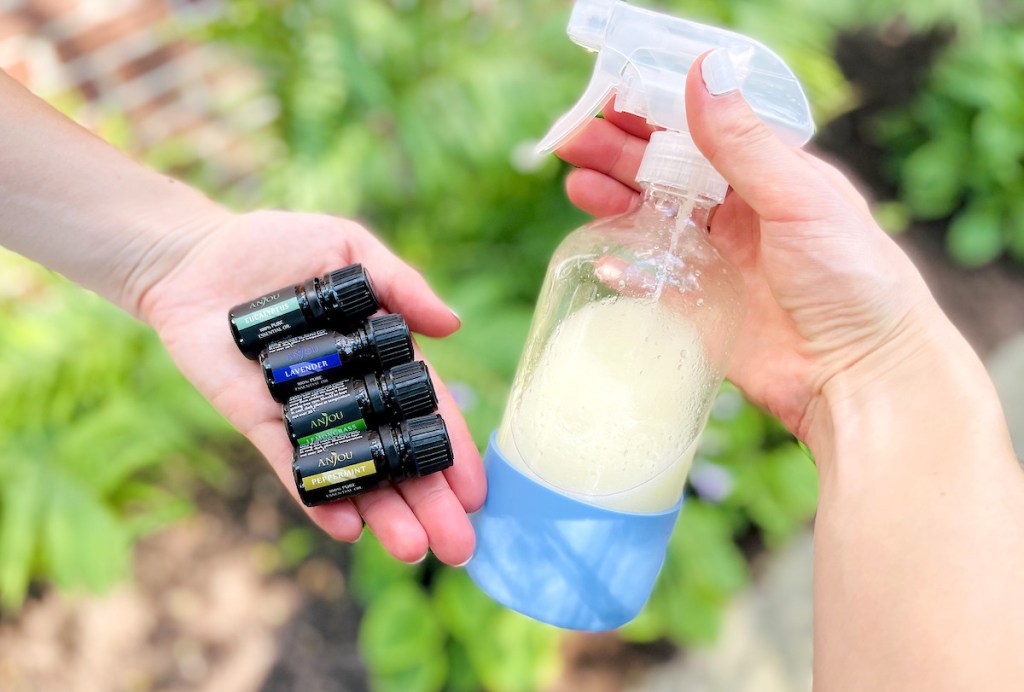
Lastly, use a glass bottle ONLY.
Storing essential oils in plastic is always a big no-no because they’re powerful and can break down plastic over time which can leak toxic chemicals. This makes them ineffective and dangerous for your health, too.
Additionally, UV rays are also very damaging to essential oils. Rapid oxidation alters the chemicals in essential oils, which, over time, breaks down the oils and negates their effectiveness. Store your homemade bug spray in a darker-colored bottle (such as amber) to minimize this risk.
Regardless, a glass bottle is your safest option and since I already had a clear bottle and plan to store my bug spray inside my kitchen cabinet (which is cool and dark), I used what I had on hand.
*I used a 16-ounce clear bottle which was more than big enough for this recipe.
Now, let’s make some awesome homemade bug spray!
Homemade Bug Spray with Essential Oils
PrintSupplies Needed
Directions
1
Add 30 drops of Lemongrass essential oil to your spray bottle.
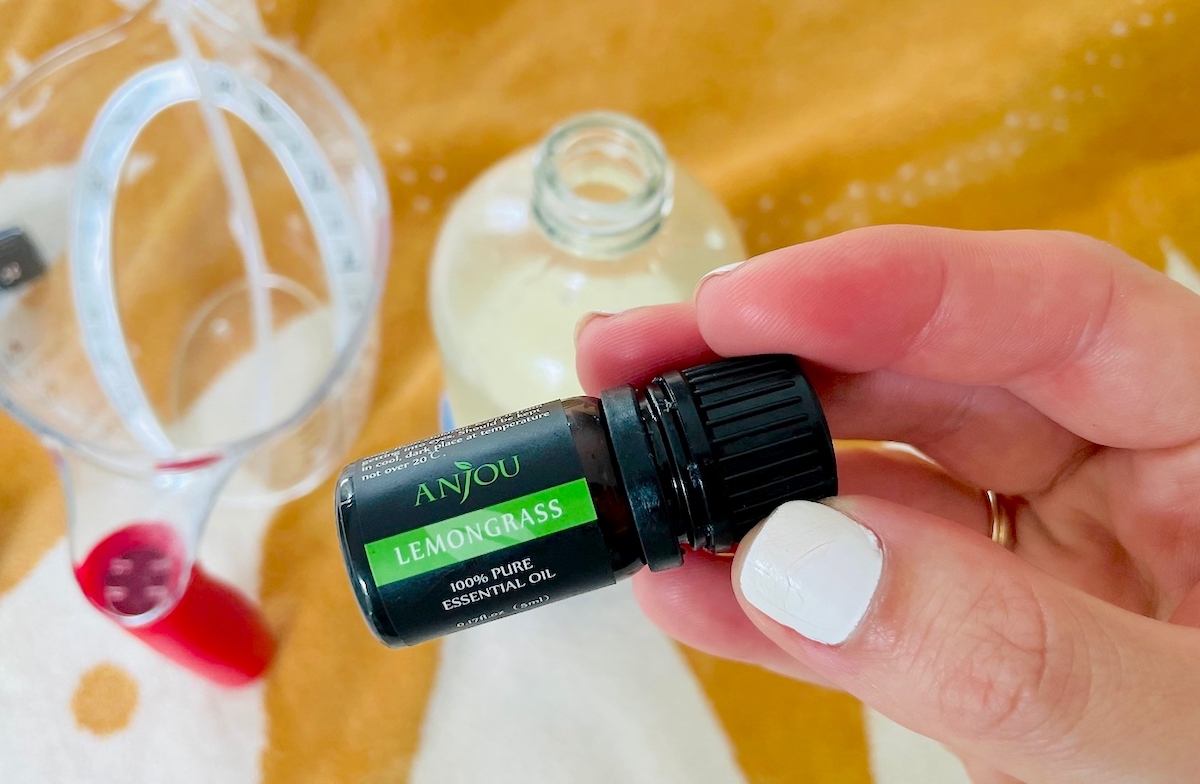
2
Add 30 drops of Peppermint essential oil to your spray bottle.
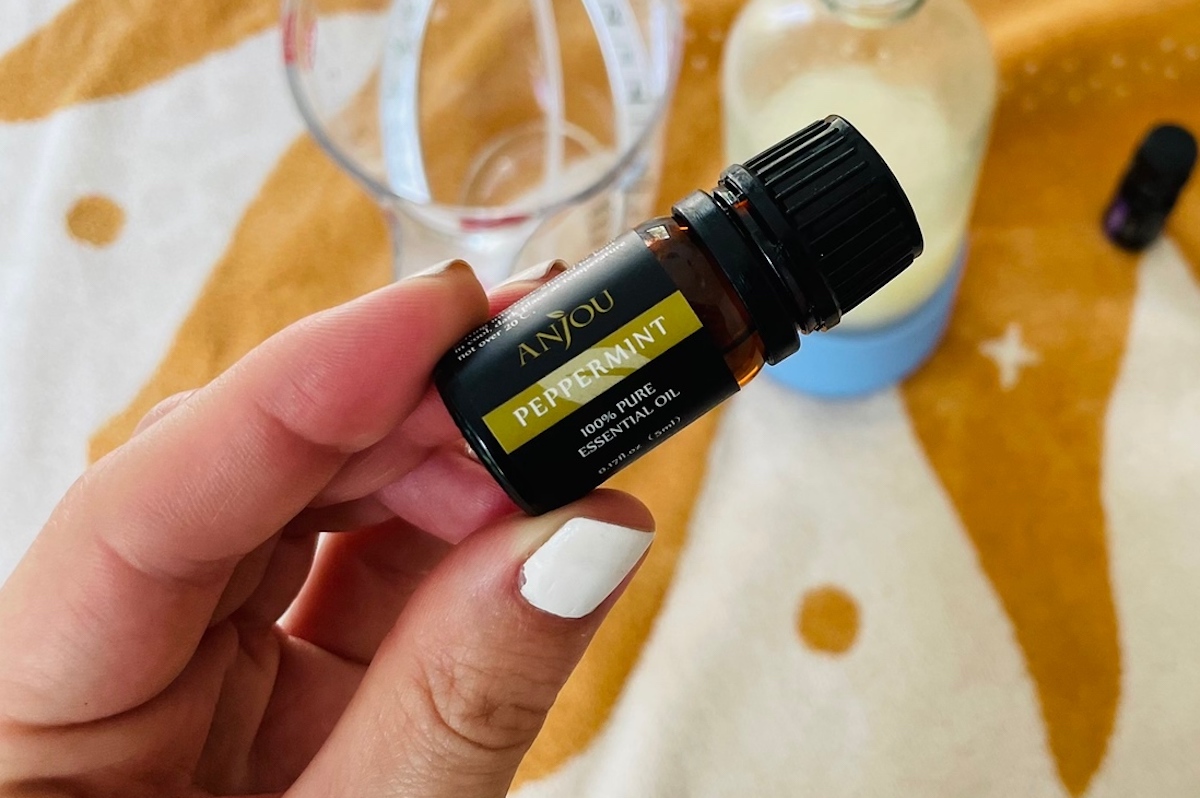
3
Add 20 drops of Lavender essential oil to your spray bottle.
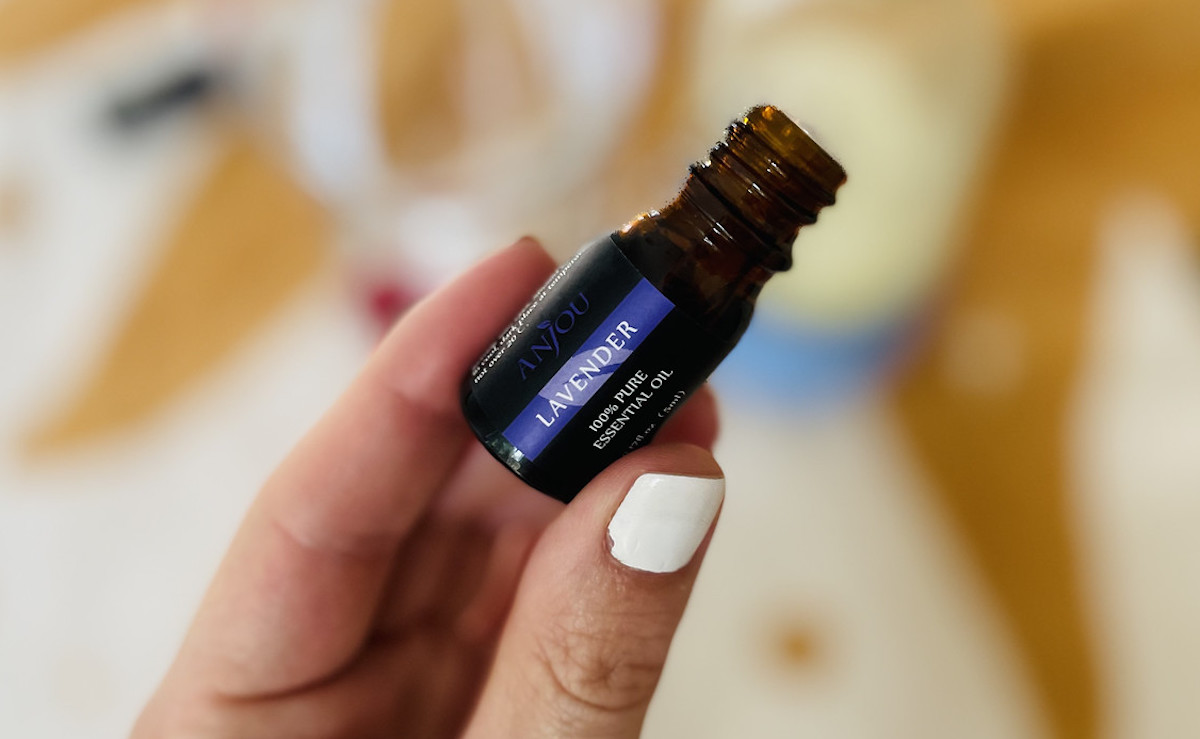
4
Add 20 drops of Eucalyptus essential oil to your spray bottle.
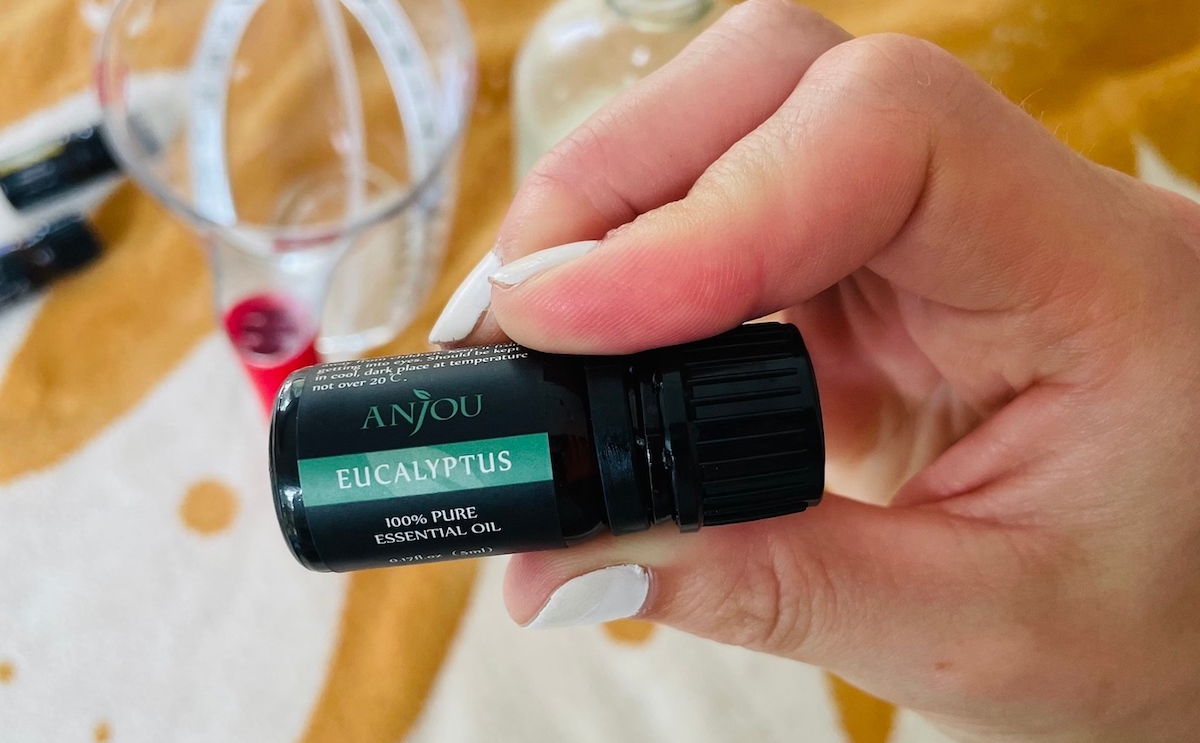
5
Measure 1 cup of distilled or filtered water and pour it into your spray bottle.
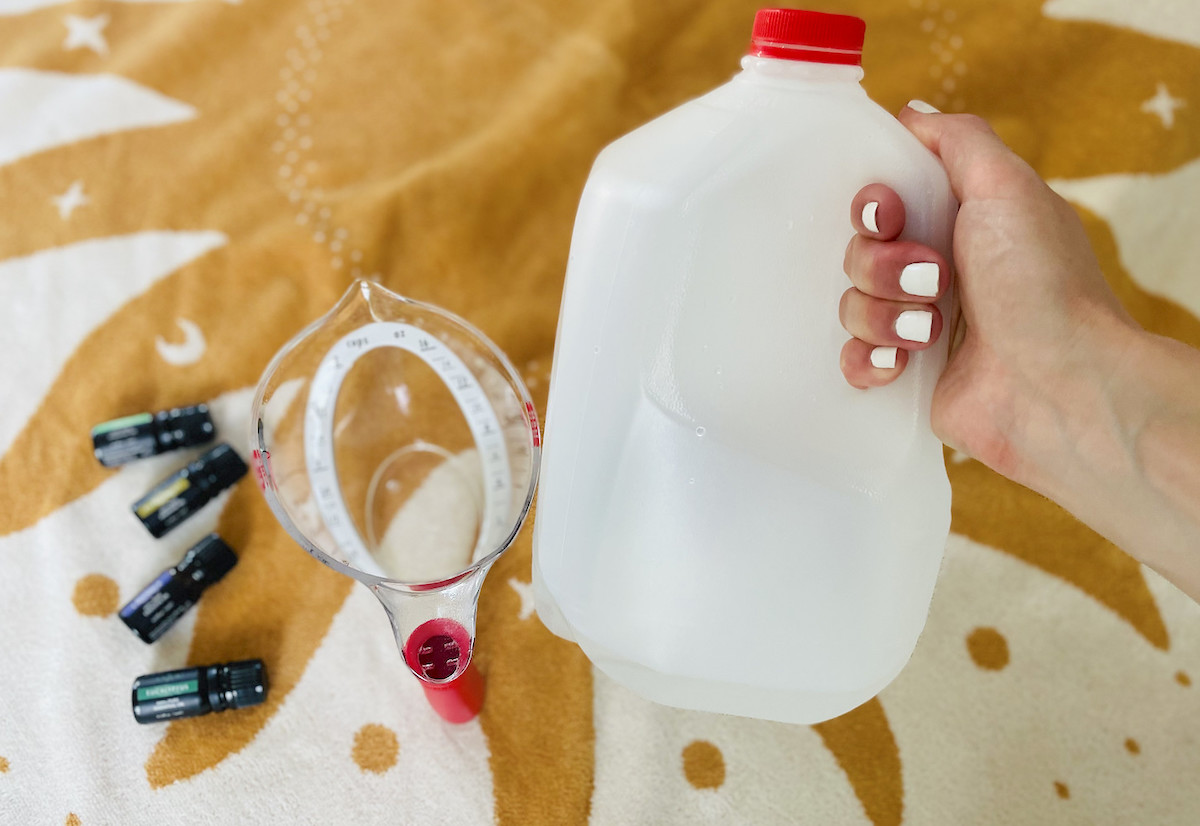
6
Measure 1/3 cup of your carrier oil and pour it into your spray bottle.
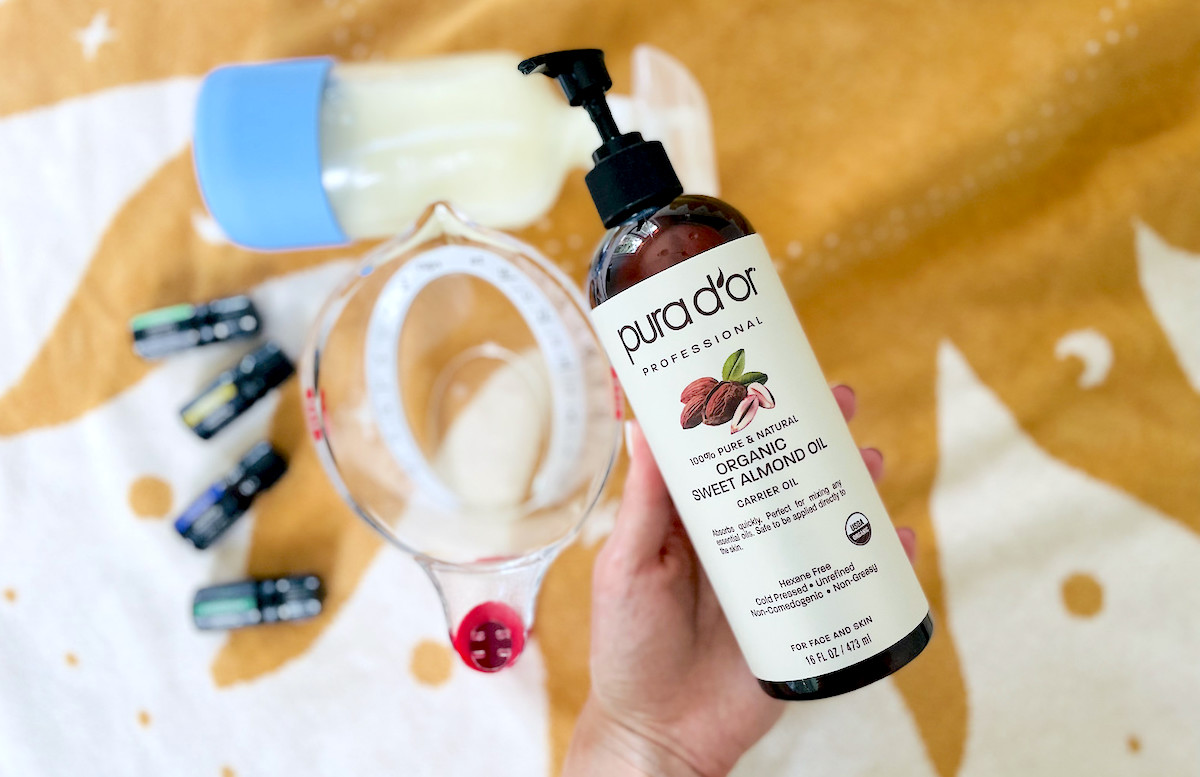
7
Screw the lid onto your spray bottle and shake well.

8
Shake the bottle before applying the spray to make sure the oils and water are thoroughly mixed. Enjoy your bug-free day!
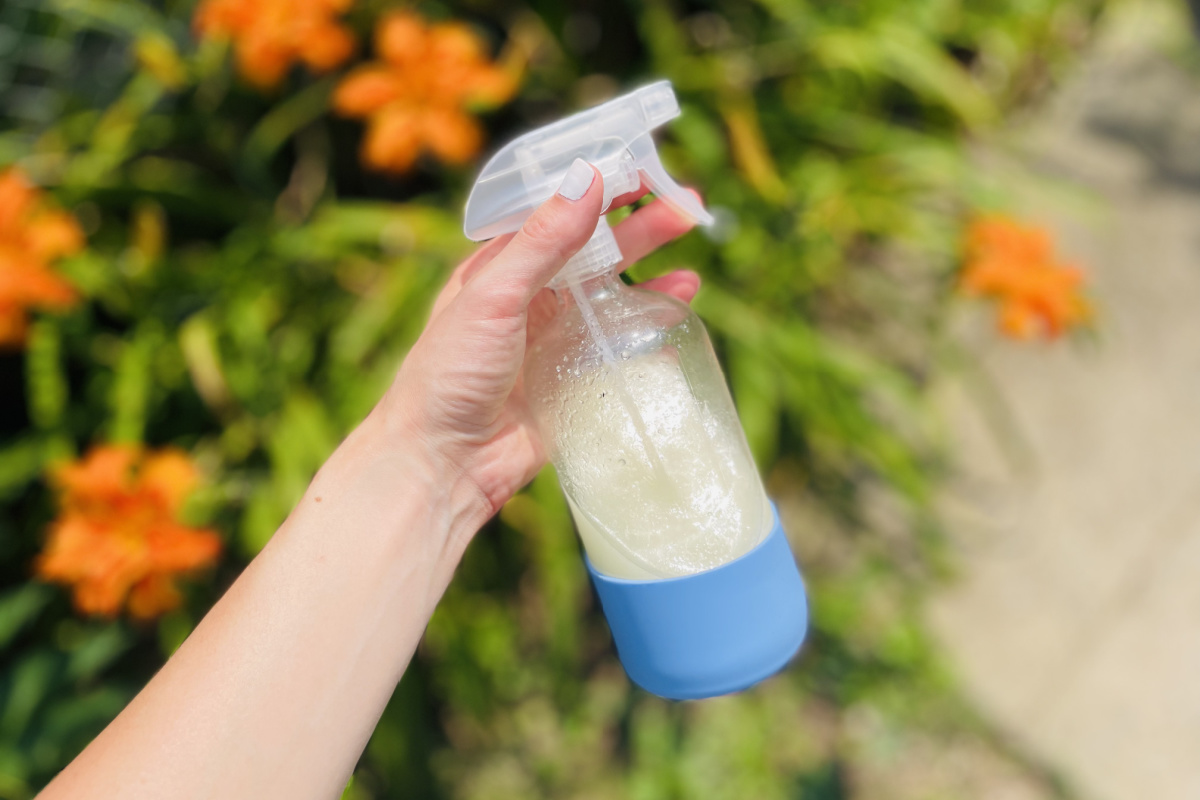
TIP: Notice some separation after making your homemade bug spray?
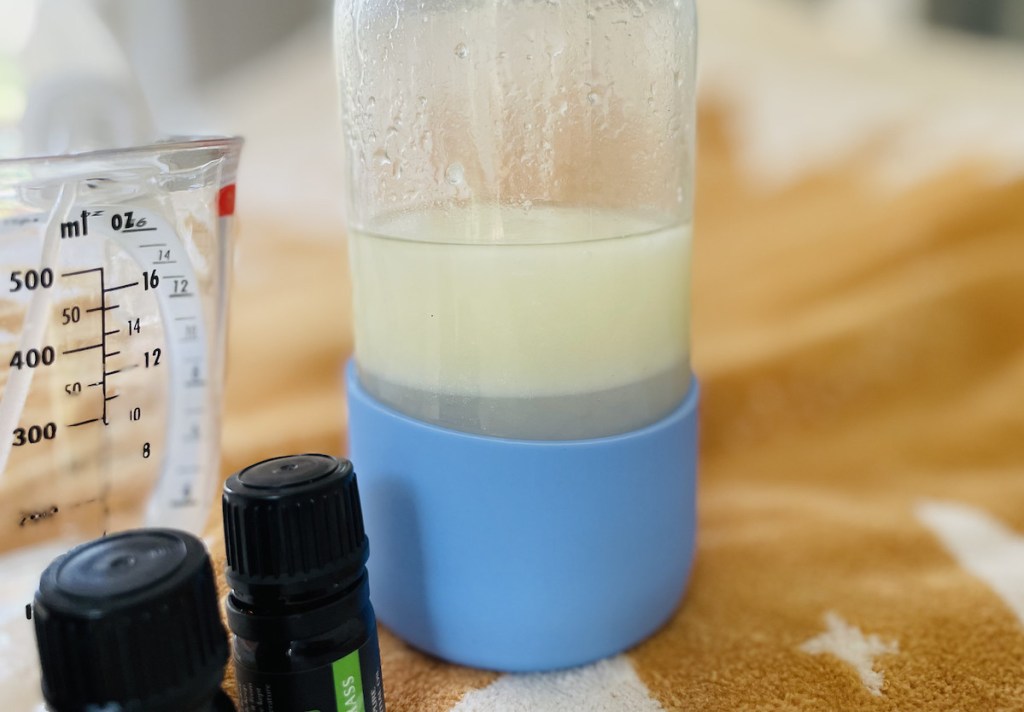
Not to worry, my friend!
You will notice separation over time – even minutes after shaking. This is a normal occurrence since my recipe contains water and oil (a pair that notoriously does not mix) and it’s not anything to worry about. Separation does not affect the essential oils or the effectiveness of the bug spray.
Simply shake before each use and you’re good to go.
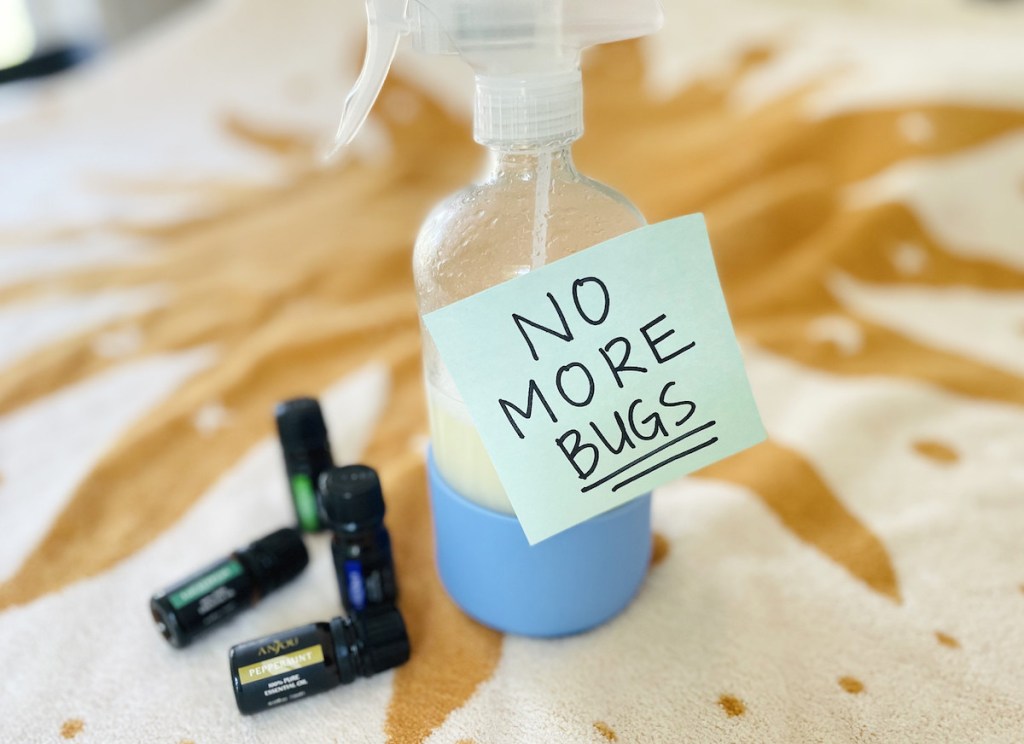
I truly hope you enjoy this homemade bug spray recipe! It’s perfect for the whole family, affordable, and so refreshing to spray on a hot day. Best of all, it’s a convenient homemade bug spray that really works! 👏
Happy summer, Hip2Savers! ☀️
Want to buy the best bug repellant instead? This one’s edible!


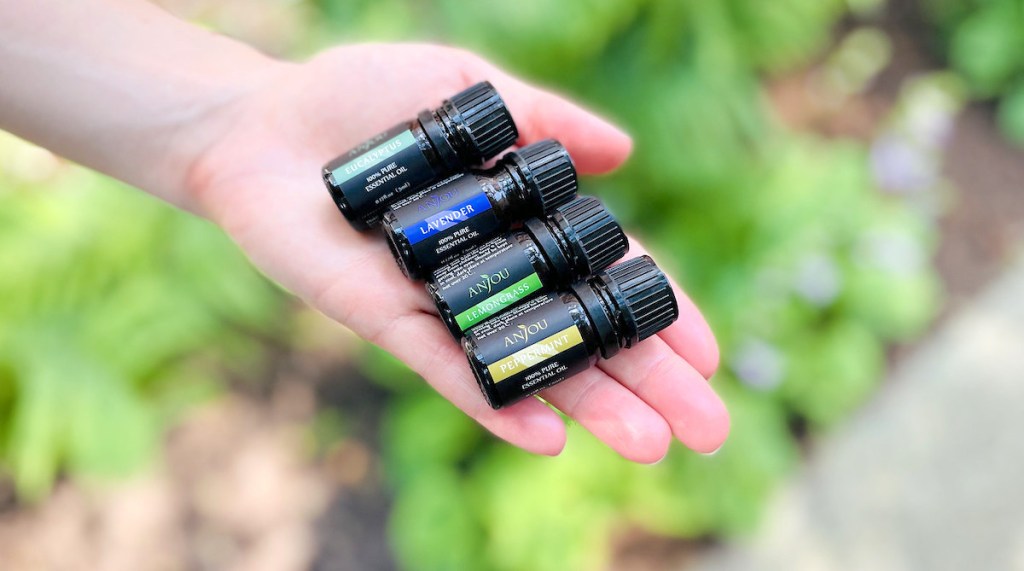


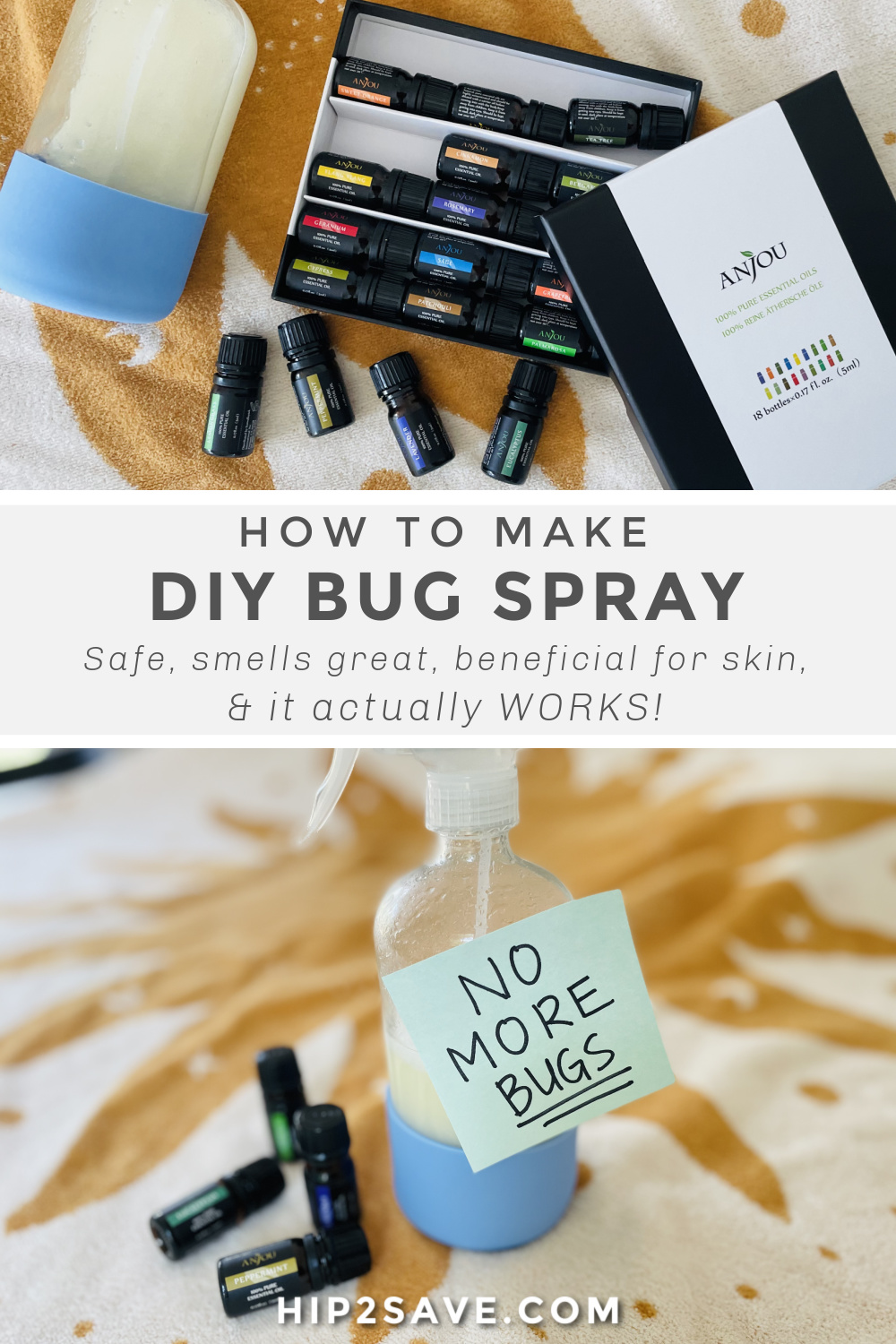

Would olive oil work as a carrier oil?
Hey, Materof6 – that’s a great question!
Yes, olive oil can be used as a carrier oil. However, due to olive oil’s greasy texture and strong scent, I would not recommend it for this bug spray recipe.
For best results, I would recommend jojoba or almond oil as mentioned in the post. If those don’t work for you, some other lightly-scented options for carrier oil could be apricot kernel, argan, avocado, camellia, coconut oil, evening primrose, grapeseed, hazelnut, hemp seed, macadamia, meadowfoam, rosehip, sesame seed, or sunflower oil. Just make sure before purchasing any of these that they’re organic, unrefined, and safe for your skin. I hope this helps!
Is this ok to spray on clothing as well, or will the oils leave stains?
I haven’t tested this on clothing. However, I have sprayed it on my skin while clothed and haven’t experienced any issues with staining. I hope this helps, Liz!
Is it okay to use the amber colored bottles? I noticed yours is clear. How big a bottle is needed?
I just reread the post & saw about the amber bottles, so what size bottle is best?
Yes, an amber bottle is actually preferred. 🙂 If you’re following the recipe exactly, I would recommend a bottle that will hold at least 1 and 1/3 cups or 10.67 fluid ounces to accommodate the carrier oil and water. A little room to spare for the essential oils would be necessary too. I hope this helps!
Could i use coconut oil as a carrier oil instead?
Yes, coconut oil can be used as a carrier oil. 🙂
Therapeutic grade essential oils are best for skin. Are these Therapeutic grade?
Hi Jennifer! Yes, the kit I have linked is 100% Pure & Therapeutic grade. I hope this helps!
I see the recipe, but I don’t see how this works? Essential oils evaporate very quickly, so do you apply every 20 minutes? With Zika and Lyme disease out there, I can’t take any chances that this doesn’t work. Any information o how this was tested would be great. Thanks!
Hey Dee!
I tend to reapply this as needed once I don’t smell essential oils anymore. For me, it has worked wonderfully with all the mosquitoes we have in our neighborhood. I have not ever had a problem with ticks either, but I do know some areas are experiencing higher volumes this season.
If you’d still like to try this natural approach to battling bugs but think you need more potency, you can definitely make this recipe stronger by not diluting it as much. However, please consult with your doctor first as high concentrations may not be safe for regular & consistent daily skin applications.
Appreciate your quick reply! I live in the woods, so ticks are definitely a problem. The only thing that keeps them off is Deet. Always looking for alternatives, though. I was really hoping for a test or study that showed this works. Not willing to send my babies out possibly unprotected. So, you’re not aware of any testing of this product to see if really works? I’m well aware of reactions to essential oils, as I have had breakouts from them. Also headaches from some oils.
Hi Dee – I would suggest that you research some of the websites that sell therapeutic grade essential oils. I know of several websites that have certified aromatherapists who post recipes for things like this and also discuss the use of essential oils safely. Several years ago, I searched for a natural fly repellent spray for our horses. I have had good luck with natural formulas but they do require more frequent application than chemical laden products.
Thanks for sharing your feedback, Falcon! Dee, just to piggyback off what Falcon said, the essential oils I used and linked to throughout the post are 100% Pure and Therapeutic grade if you do decide to go this route. But again, since ticks aren’t a problem where I live I wouldn’t say this has been strongly tested in this area.
We love the Badger brand, it’s natural and Celiac-safe ❤
Thanks for sharing, Kathleen!
Thank you so much! this was such great information! And what a great deal! Bought mine 🙂
Awesome, Julie! Enjoy your new essential oils and if you make the bug spray please let me know what you think!
Do you think this would work if the oils were mixed into an unscented cream or lotion instead of made into a spray?
Hey, Leslie! You can definitely make a bug cream that works, but I have never personally tried it. I use this bug cream and absolutely LOVE it if you’d like to check it out or maybe see what ingredients they use so you can try to mimic it on your own. Let me know what you decide to do and how it turns out if you do make it! 🙂
Do you think this would work in a roller bottle without the water? If so, what would the ratio be? Thanks!
Hey Joan, we are not certain on that as we haven’t tried it.
We do have this noted above – “*Note it’s recommended to use a 0.25%-0.5% dilution for children under the age of 2. Always consult with a doctor before using any topical product on your skin, especially for children or women who are pregnant or nursing.”
Hope that helps.❤️
Is this safe for toddlers?
Hey Glenna! We have this recommendation noted above –
“*Note it’s recommended to use a 0.25%-0.5% dilution for children under the age of 2. Always consult with a doctor before using any topical product on your skin, especially for children or women who are pregnant or nursing.”
Thank you!
You’re very welcome! 🤗
Do you think I could use this on my porch to get rid of the bugs? I have pets. Are they safe for pets?
Hey there!
I am not sure I would spray this on your porch since there is oil involved. I would worry about build-up over time and becoming slippery. I have heard wonderful things about Wondercide if you want to try that – it is chemical free, environmentally safe, and safe for pets.
As far as using this spray on pets, I do not see why it would be an issue since the essential oils are diluted, but I would still check with your vet to be sure before using it. If you would like to buy a pet-safe bug repellent I highly recommend this natural bug repellent that’s so safe it’s considered edible!
I hope this helps answer your question. 🙂
Thak you, Sara, for sharing this amazing bug spray recipe. It’s a rare find to come across something that not only works wonders but is also kind to the wallet. Your thoughtful approach is commendable!
Thank you for stopping by to leave such a sweet comment, VINEVIDA! I’m thrilled to hear how much you love this recipe!